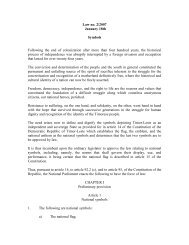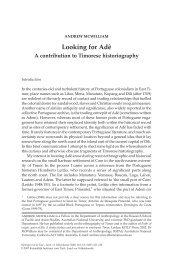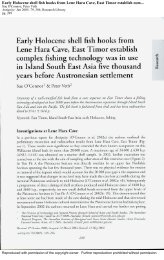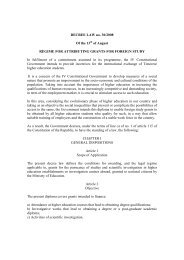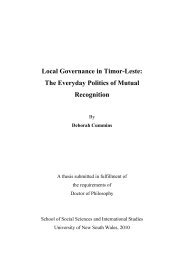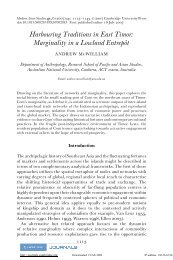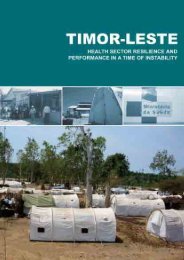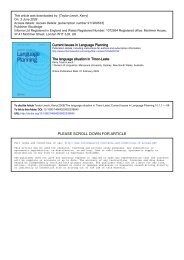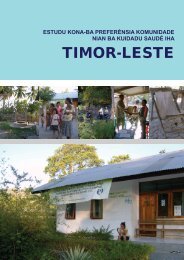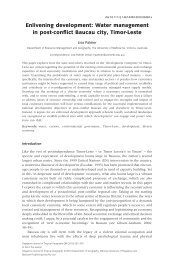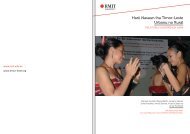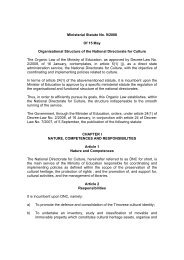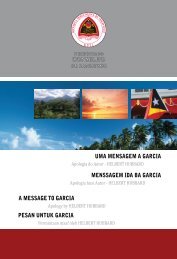Timor-Leste Health Care Seeking Behaviour Study - Secretaria de ...
Timor-Leste Health Care Seeking Behaviour Study - Secretaria de ...
Timor-Leste Health Care Seeking Behaviour Study - Secretaria de ...
- No tags were found...
Create successful ePaper yourself
Turn your PDF publications into a flip-book with our unique Google optimized e-Paper software.
The HCSBS survey investigated processes and steps that the community follow when <strong>de</strong>aling withserious illness. Data was gathered on 285 individuals reporting a serious or significant illness in thepast twelve months, approximately equal numbers of men (52.3%) and women (47.7%) aged from 0–94 years. The most commonly reported illnesses were fever (16.3%) and malaria (15.2%). Hometreatment was common, with 63% being given biomedical treatment (often paracetamol, 32%) and28.2% trying a home remedy. Almost one quarter of households (22.4%) reported consulting atraditional healer-shaman(matan dook) for the illnessand 28.8% reported takingtraditional medicine. The useof a traditional healer issubstantially higher than wasreported in answer to anearlier survey question aboutthe range of health provi<strong>de</strong>rsused (14.9%), but is moreconsistent with thequalitative findings.Almost all of those reporting serious or significant illness (95.4%) visited a health facility, most(67.5%) after one day of sickness. The <strong>de</strong>cision to go to the facility was most commonly ma<strong>de</strong> by thesick person (34.3%) or their spouse (30%); sometimes by another household member (13.0%).Facilities visited inclu<strong>de</strong>d subdistrict health centres (35.0%), health posts (20.1%) and SISCa posts(15.9%). Very few reported visiting a private clinic (Table 6).4.7 PreventionTable 6 - Type of facility visited by sick person (HCSBS sample)Facility n (%)Subdistrict government health centre 99 (35.0)Government health post 57 (20.1)SISCa post 45 (15.9)District government health centre 37 (13.1)Government hospital 35 (12.4)Private clinic 6 (2.1)Other 4 (1.4)Total 276 (100.0)Information about preventing disease was passed on mainly by health workers, and by xefe suco.Preventive behaviours by community members focused on avoiding contact with the sick, and theeating implements or sputum of the sick. Informants articulated consi<strong>de</strong>rable knowledge abouthygiene and sanitation-related actions for diarrhoea prevention. A range of other health problemswere also i<strong>de</strong>ntified as preventable but informants almost unanimously claimed they did not seekpreventive health care. Some un<strong>de</strong>rstood antenatal care as helping avoid difficulties, and hadsought this care. Provi<strong>de</strong>rs were generally aware of their preventive role and frustrated by the lowlevel of community knowledge and preventive practice. Nearly all provi<strong>de</strong>rs spoke about<strong>de</strong>livering antenatal care.In the HCSBS survey, the majority of household heads (87.9%) reported that household membersgenerally washed their hands with soap, boiled water before drinking (84.9%) and almost allhouseholds (97.6%) washed their eating utensils (Table 7). The small proportion of households thatreported they did not have soap (



